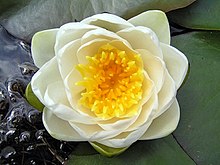Furrow pollen dicotyledonous
The division of living beings into systematics is a continuous subject of research. Different systematic classifications exist side by side and one after the other. The taxon treated here has become obsolete due to new research or is not part of the group systematics presented in the German-language Wikipedia.

The Einfurchenpollen-dicotyledonous ( Magnoliopsida ) formed a taxon of plants from the division of the bedecktsamer (Magnoliophyta) in some classifications . In current systematics, they no longer form their own taxon, since they are paraphyletic, but are summarized under the term basic orders .
features
The representatives are mostly woody plants and have essential oils ( phenylpropanoids , terpenes ), which are located in spherical idioblasts . The leaves are simple and have no stipules .
The flowers are designed very differently. There can be numerous flower organs, which are then usually arranged in a spiral, the flower organs can be arranged in three-fold circles; in some cases they are even more reduced. The carpels are often free (chorikarp). The pollen is mostly monocolpat, so it has a furrow, which is also what the German name of the group refers to.
Plants of the Magnoliopsida often contain benzylisoquinoline alkaloids and the neolignans, which are biosynthetically related to them .
Systematics
The furrow pollen dicotyledonous are paraphyletic , which means they are unlikely to include all of the descendants of their last common ancestor. They encompass the basal groups of the covers and have a lot in common. A total of around 10,000 species are distinguished.
The relationships are now reasonably well known through molecular biological studies. They can be shown in the following cladogram , which also contains the other two classes of the covering plants. Taxa belonging to the Magnoliopsida are written in bold:
|
|
|
|||||||||||||||||||||||||||||||||
|
|
The relationships between the five upper groups have not yet been clarified with sufficient certainty, so that no clear division can be made here.
The Magnoliopsida are divided into four subclasses containing nine orders, with two orders not being assigned to any subclass:
- Amborellales with the only kind:
- Star aniseed (Austrobaileyales)
- Subclass water lily-like (Nymphaeidae)
- Subclass Ceratophyllidae
- Subclass Chloranthidae
- Subclass magnolia-like (Magnoliidae)
- Magnolia-like (Magnoliales)
- Laurels (Laurales)
- Canellales
- Peppery (Piperales)
literature
- Peter Sitte , Elmar Weiler , Joachim W. Kadereit , Andreas Bresinsky , Christian Körner : Textbook of botany for universities . Founded by Eduard Strasburger . 35th edition. Spectrum Akademischer Verlag, Heidelberg 2002, ISBN 3-8274-1010-X (The systematics presented follows the 34th edition, see Systematics of Bedecktsamer ).
Individual evidence
- ↑ Angiosperm Phylogeny Group: An update of the Angiosperm Phylogeny Group classification for the orders and families of flowering plants: APG III In: Botanical Journal of the Linnean Society, 161: 2, 2009, pp. 105-121
- ^ PS Soltis, DE Soltis: The origin and diversification of Angiosperms . American Journal of Botany, Volume 91, 2004, pp. 1614-1626. on-line